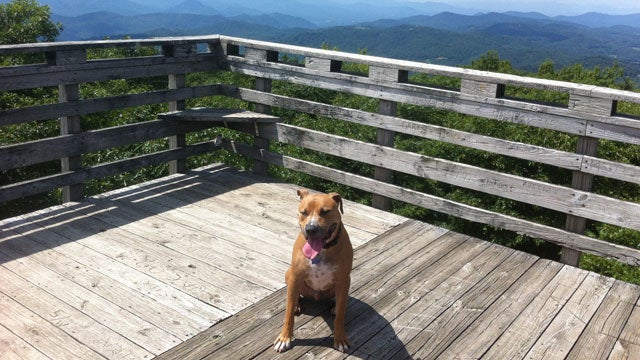I knew I had a special dog when he attempted to undress the first two women I introduced him to, not counting my mom. (He's got good taste: one became my girlfriend.) Named after the jazz musician and my childhood dentist, Walter Ray Miles Davis Jr. likes the flavor of blouse buttons and the dangle of lady garments. He humps when he gets nervous, which is often. Once his tan forepaws wrap around a leg, you need a bucket of cold water or a rack of ribs to pry him off. As you try, with whatever implements are at hand, his pleading hazel eyes look up at you, as if to say: “Can you just give us one more minute of privacy here, boss?” I've considered buying a human blow-up doll for Miles, but I fear it wouldn't survive his affection.
Miles is seventy-five pounds of muscle, three years old, and prone to sinuous wiggling fits.
I knew Miles was special, in a very different way, before the disrobing and humping began: he had a white scar around his skinny rump when I first saw him last Spring, after a breakup. He bounded around the backyard of his foster family in Clarkston, Georgia, like a huge, deranged rabbit. When he finally stopped, he let me touch the scar. Then we went inside and wrestled on the floor.
Allowing me to touch him there was a rare show of trust; the drooling, however, was standard issue.
I can't explain why he chose me any more than I can explain why he won't run at full speed on a leash or eat those expensive rawhide bones I bought in bulk when he arrived at my home with the small yard in the middle of downtown Atlanta. But he did, and nothing has been the same since.
Miles is seventy-five pounds of muscle, three years old, and prone to sinuous wiggling fits. get the at the “shelters” in Atlanta's Dekalb County, where he was on death row two years ago, sharing a tiny cell with cockroaches and rats.
His crime: a blocky head, compact body, short coat, triangular ears and a rat-like tail. All of these traits are, sadly, synonymous with violence: if not perpetrated by these so-called “pit bulls,” than that which is committed against them by humans. I'll never know the exact cause of Miles' scars, or (god knows what I'd do with it) the names and addresses of his abusers. But it's clear that Miles was wrapped up with a sharp wire that left him lookingÔÇöif I'm in a mood to joke about itÔÇölike he's permanently wearing a garter belt. He was nearly cut in half.
According to Ken Foster's folksy and personal celebration, , the term “pit bull” is used to describe ten to twenty percent of the dogs found in the United States. These dogs may or may not be kin to the American pit bull terrier, the American Staffordshire terrier or the English Staffordshire terrier, breeds that share some combination of the physical characteristics noted above. To most media and lawmakers, they are all simply “pit bulls,” and a threat to the public.
Anything resembling such a dog is , and cannot be kept in most apartment and condo buildings nationwide. Even PETA and the Humane Society advised that the pit bulls that narrowly avoided death at Michael Vick's hands be killed. Imagine that sentence being handed down to maimed yellow labs.
In truth, the range of dogs referred to as “pit bulls” make incredibly gentle, loyal companions. Historically, they've on the American Temperament Test of dog breeds, outperforming many more popular dogs. According to the ATT, they're better tempered, on average, than the ballyhooed .
The dogs we call pit bulls arose in England, Scotland and Ireland in the mid-1800s, where they helped round-up large prey, often in so-called “bull pits.” From this original mixing, we've gotten everything from the French bulldog to the Bull Mastiff. The defines the American pit bull terrierÔÇöwhat most of his mean when we say “pit-bull”ÔÇöas “a dog that combined the gameness of the terrier with the strength and athleticism of the Bulldog. The result was a dog that embodied all of the virtues attributed to great warriors: strength, indomitable courage, and gentleness with loved ones.”
“A pit bull is American,” writes Ken Foster, “and like most Americans, these dogs are a jumble of DNA and contradictions, which is, naturally, what pit bull lovers love most about their dogs.” Which takes us back to Miles, who has contradictions aplenty.
He'll face off against a 140-pound Mastiff at the dog park, but he won't get near a hula-hoop. He'll let me hog-tie him, lay on him, and turn him into a toothy lawnmower, but if he doesn't know you or your dog, well, you'd better heed : “A fragile and very sensitive big-ass dog lives here.”
On my way to Mexico to climb this past January, I got a voicemail from my dad, who was taking care of Miles. “We've had a little incident here,” he said gravely, “involving Lucky and Miles.” My pit had gotten the best of his pit in a fight over a bowl of kibble. Since both are rescues, locked in eat-or-die mode, we'd carefully socialized them over the first five months I had Miles. They played roughÔÇöoften approaching the cusp of simultaneous canicideÔÇöbut never before had they both gone for the jugular.
“Lucky has a deep cut down the middle of her chest,” dad continued on the phone. “Mary”ÔÇömy step-momÔÇö”is pretty upset.”
Miles wasn't welcome back for quite a while after that, even once Lucky's stiches were removed. But to Mary's credit, they've been allowed to reunite with close supervisionÔÇöI keep a spray bottle of water handy at all times, ready to give a reprimanding spritz to the muzzleÔÇöand have played for many hours since, without incident. (Observing this “play” still takes some getting used to: it is to normal dog romping what the UFC is to the WWF.)
But pax canis did not last long. Over the next few months, Miles suddenly started nipping at people every once in a while: a pool guy, a neighbor, my girlfriend's older sister and a cat-loving pal of mine were among those scared shitless.
None had done more, it seemed, than reach down to touch him. But in some unknown way, I thought, they must have reminded him of his abusers. Smokers perhaps? Yankees fans? Cat lovers? These incidents left me having to explain this fact again and again: Miles lashes out in fear because he's been abused, not because he's a “pit bull.”
And was he even a “pit bull”? My father spent seventy-five bucks on something called the “” in order to find out. He sent off a swab of Miles' saliva, and few weeks later we got an email: he's a 'Boxer mix' crossed with 'American Staffordshire Terrier,' it said. From the email: “The Wisdom Panel┬« InsightsTM computer algorithm performed over seven million calculations using 11 different models (from a single breed to complex combinations of breeds) to predict the most likely combination of pure and mixed breed dogs in the last 3 ancestral generations that best fit the DNA marker pattern observed in Miles Davis.” So he was half pit, whatever that meant.
I found this passage in Foster's book: “For better or worse, the adage goes, our dog's behavior is attributed to their DNA … making it, inevitably, a great family dog, a great hunter, or an alert guard dog. But most of these people are just repeating notions that have been handed down like folklore, rather than via the study of genetics. It is a notion of predicting behavior that we would never claim in humans.” Well, almost never. But the point is well taken: behavior is more than genetics.
This summer, Miles scaled his first mountainÔÇöÔÇöalmost entirely off-leash. This freedom owed more to the remoteness of the trail and the absence of dogs/humans to tangle with than any great advances he's made in socializing. I was surprised he made it up the three miles and one thousand feet of elevation without bonking, given how he reacts to a ten-minute city jog. But as he sat atop the observation tower, collapsing in the lone sliver of shade, I got a little misty thinking how far he's come from that Dekalb County cell.
As I type this now, he's curled up in the backseat of my car, in the space not occupied by a cooler full of steak sandwiches.┬á We're on the way home from Texas, the seventh state we've visited together. It was a solid 18 hours from Atlanta to a 300-acre ranch in the hill country outside Marble Falls where we'd meet much of my girlfriend's familyÔÇöMiles reacting poorly to only one of themÔÇöbut I wanted him to come. A dog needs to roam, and Miles hasn't roamed nearly enough.
Free to explore the ranch, he was constantly amazed: the sun was hotter, the prickly things pricklier, and the animals diverged from the squirrel, dog and cat categories he knew. In seventy-two hours, he saw (and chased or ran from) coyotes, lizards, deer, feral pigs and three bikinied sisters. He rolled around in the dirt, howled at the moon, briefly disappeared in pursuit of a pig. So now he's exhausted in the back seat, dreaming about whatever it is that dogs dream, and I'm planning our next trip. I think he'd like the feel of a canoe.


